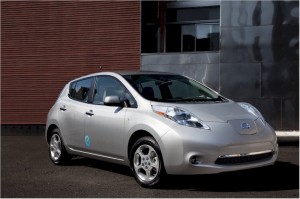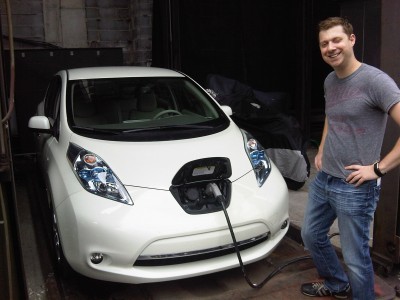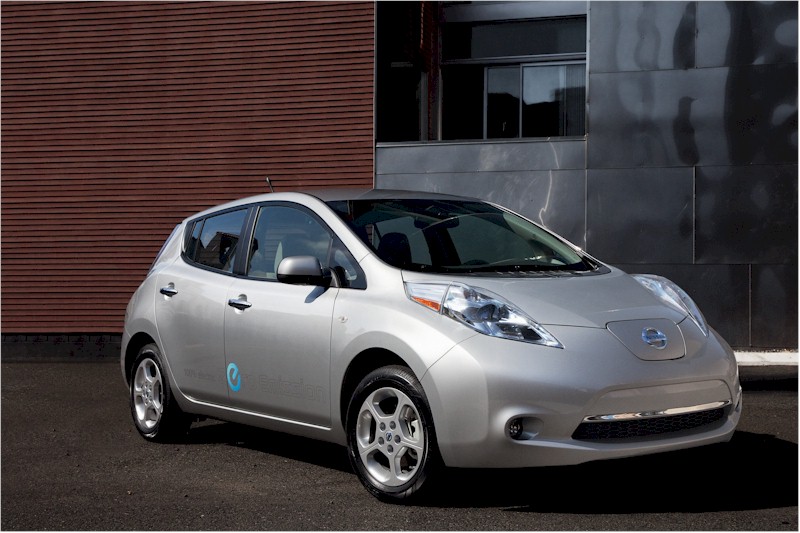 You’ll never visit a gas station while driving an electric-powered Nissan Leaf. But if you don’t have somewhere to keep it plugged in when not in use, get ready to spend lots of time on Google Maps, carefully planning each trip. For a New York apartment dweller like myself, someone who routinely drives short distances but doesn’t have a garage, the Leaf offers the best (and worst) of both worlds.
You’ll never visit a gas station while driving an electric-powered Nissan Leaf. But if you don’t have somewhere to keep it plugged in when not in use, get ready to spend lots of time on Google Maps, carefully planning each trip. For a New York apartment dweller like myself, someone who routinely drives short distances but doesn’t have a garage, the Leaf offers the best (and worst) of both worlds.
Like all electric cars, the Leaf operates in near silence and offers the feel good benefit of zero emission driving. However, a range of approximately 110 miles makes long trips difficult, if not impossible. That’s where the Leaf’s capabilities, and a weekend getaway, came into conflict. The Leaf could make the trip to Asbury Park, New Jersey, but the battery didn’t have enough juice for the ride home to N.Y.C.
My partner, Matt, and I searched online for charging stations at our destination. No luck.
The Leaf also has a satellite navigation system that shows the nearest charging points – though it didn’t always jive with what we were finding online, and vice versa. Our planned trip to “da’ Jersey shore” was looking like more trouble than it was worth. Sorry Snooki, we’ll catch you next time.
If you’re thinking about buying an EV, be certain to factor in your driving habits and whether or not you have a reliable spot to keep it charged. To be fair, that’s a quirk of all electric cars. So how does the Leaf stack up in terms of design, cabin comfort and performance?
Getting people behind the wheel would ease a lot of trepidation. The Leaf rides and handles like a normal car, with little in the way of extraneous gadgetry to get in the way. The automatic transmission’s chunky control knob – it looks like an oversized computer mouse – and the gauge cluster’s cool blue readings for battery charge add a nice touch of tech to the cabin. Acceleration is strong in town, though it’ll take about 10 seconds to accelerate from zero to 60 miles per hour. Top speed is limited to 92 mph.Nissan purposefully kept the Leaf’s design conservative, since the automaker figured the electric powertrain was enough of a leap forward for most customers. Edgy early-adopters might want something flashier if they’re going to hand over $33,600 (base price, before federal and state tax credits). The 5-door hatchback shape is a little bland, though Nissan can always introduce wilder styling once customers get more used to the idea of electric cars.
The Leaf is exceptionally slick during city driving. My partner and I rolled down the windows while the 107 horsepower electric motor and lithium-ion battery pack operated in total silence. Engine noise suddenly seems so last century in a Leaf. Having rearranged our weekend plans to suit the car, we at least found it remarkably easy to drive. More steering feel would be nice; the Leaf is nimble, but the front-wheel-drive hatch is not what I’d call sporty.
But hey, the kids love it.
Automakers shouldn’t be too worried about the next generation of car buyers opting for EVs. Almost every thumbs-up came from the 12-and-under crowd – one kid had his dad roll down the window so he could shout “cool car!” as we sat in a traffic jam.

All the city driving finally added up. With only 18 miles of range left on the Leaf, we located a parking lot on the Lower East Side with a charging station. The attendant told us we were the second EV to use the recently installed system. A flap on the nose of the car covers the 220-volt charging port. I had Matt pose as we officially marked our first EV recharging memory in NYC. Does Hallmark make a card for that?
We budgeted two hours for recharging the Leaf – and took that time to replenish our own batteries with a relaxed lunch around the corner. That was enough to bump the driving range back to 55 miles. A full recharge would have required several more hours. Using a normal 110-volt plug and outlet means waiting upwards of 10-12 hours, or more.
The Leaf is good, though not for everybody. While electric cars seem custom-made for city driving, the infrastructure isn’t quite there to keep them humming along. A quieter suburban existence, with a cozy garage and nightly recharge, is where the Leaf works best – probably as a second car.

Here’s the problem with any car as a NYC dweller; there’s absolutely no reason to have a car to travel within the city. None. Cabs, car service or subways are cheaper and less of a headache. The only reason to have a car in the city is to drive substantial distances outside the city. 130 miles to the beach, which I try to do as often as I can. Plus 70 miles round trip to NJ for work 2-3 times per week. My 340hp manual transmission Audi S4 is not really suited for it.
For the Leaf (or the Volt) the garage manager in my building said he’d set me up with a dedicated space for a plug, which solves one problem. The distances that I need to drive rule out the Leaf, unless I’m willing to stop in Queens to recharge on my way to Montauk. I am not going to stop in Queens willingly, and I don’t want a car that ensures that I’ll have to. Even my 70 mile roundtrip NJ commute is cut close with the limited range in the Leaf. Do I dare use the A/C or run the windshield wipers? I’m not willing to deal with the anxiety of that. The Leaf feels Yugo cheap and the third-world styling is just ugly… but I was considering overlooking these faults for a zero emission vehicle.
The Volt is still a consideration. Although the plug-in electric aspect is little more than a novelty because of the reliance on the gas engine after about 40 miles. So I’ll still be stopping at gas stations frequently, even though a little less so. I sat in one, and I liked it. I’ll need to test drive one to see what I think.
So right now I’m adding two diesels to my shortlist. The Audi A3, the VW Passat. I”m not sure that electric cars are quite there yet.